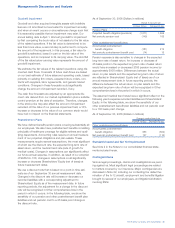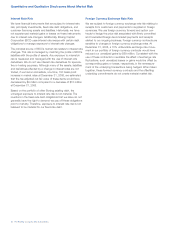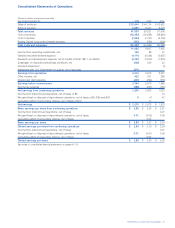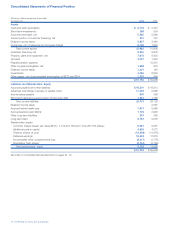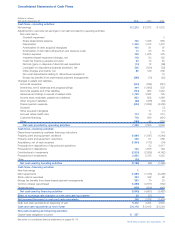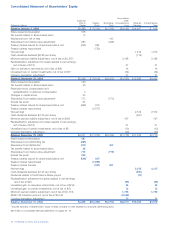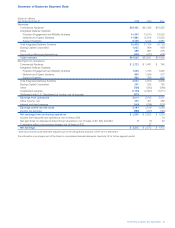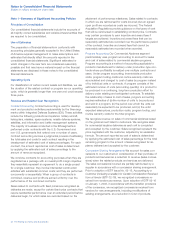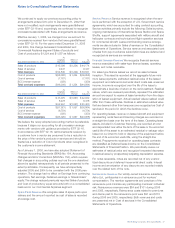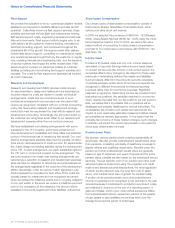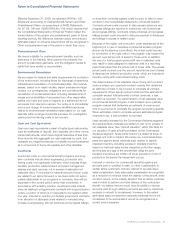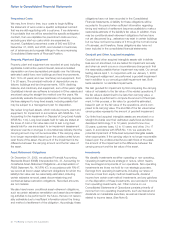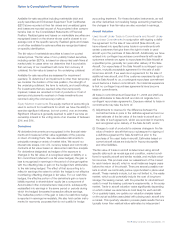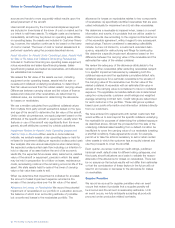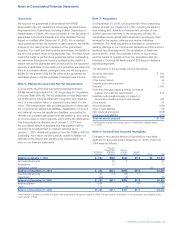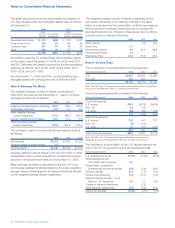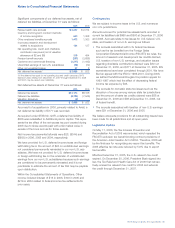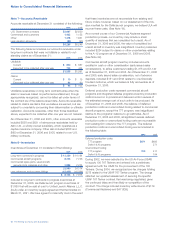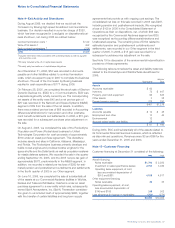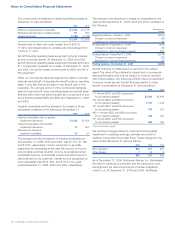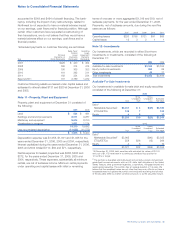Boeing 2006 Annual Report Download - page 51
Download and view the complete annual report
Please find page 51 of the 2006 Boeing annual report below. You can navigate through the pages in the report by either clicking on the pages listed below, or by using the keyword search tool below to find specific information within the annual report.The Boeing Company and Subsidiaries 49
Notes to Consolidated Financial Statements
Effective December 31, 2006, we adopted SFAS No.158,
Employers’ Accounting for Defined Benefit Pension and Other
Postretirement Plans – an amendment of FASB Statements
No. 87, 88, 106 and 132(R) (SFAS No. 158) which requires that
the Consolidated Statements of Financial Position reflect the
funded status of the pension and postretirement plans. In future
reporting periods, the difference between actual amounts and
estimates based on actuarial assumptions will be recognized in
Other comprehensive loss in the period in which they occur.
Postemployment Plans
We record a liability for postemployment benefits, such as
severance or job training, when payment is probable, the
amount is reasonably estimable, and the obligation relates to
rights that have vested or accumulated.
Environmental Remediation
We are subject to federal and state requirements for protection
of the environment, including those for discharge of hazardous
materials and remediation of contaminated sites. We routinely
assess, based on in-depth studies, expert analyses and legal
reviews, our contingencies, obligations and commitments for
remediation of contaminated sites, including assessments of
ranges and probabilities of recoveries from other responsible
parties who have and have not agreed to a settlement and of
recoveries from insurance carriers. Our policy is to immediately
accrue and charge to current expense identified exposures
related to environmental remediation sites based on our best
estimate within a range of potential exposure for investigation,
cleanup and monitoring costs to be incurred.
Cash and Cash Equivalents
Cash and cash equivalents consist of highly liquid instruments,
such as certificates of deposit, time deposits, and other money
market instruments, which have original maturities of less than
three months. We aggregate our cash balances by bank, and
reclassify any negative balances to a liability account presented
as a component of Accounts payable and other liabilities.
Inventories
Inventoried costs on commercial aircraft programs and long-
term contracts include direct engineering, production and
tooling costs, and applicable overhead, which includes fringe
benefits, production related indirect and plant management
salaries and plant services, not in excess of estimated net
realizable value. To the extent a material amount of such costs
are related to an abnormal event or are fixed costs not appro-
priately attributable to our programs or contracts, they will be
expensed in the current period rather than inventoried. In
accordance with industry practice, inventoried costs include
amounts relating to programs and contracts with long production
cycles, a portion of which is not expected to be realized within
one year. Included in inventory for federal government contracts
is an allocation of allowable costs related to manufacturing
process re-engineering. We net advances and progress billings
on long-term contracts against costs incurred to date for each
contract in the Consolidated statements of financial position.
Contracts where costs incurred to date exceed advances and
progress billings are reported in Inventories, net of advances
and progress billings. Contracts where advances and progress
billings exceed costs incurred to date are reported in Advances
and billings in excess of related costs.
Because of the higher unit production costs experienced at the
beginning of a new or derivative commercial airplane program
(known as the learning curve effect), the actual costs incurred
for production of the early units in the program may exceed the
amount reported as cost of sales for those units. In addition,
the use of a total program gross profit rate to delivered units
may result in costs assigned to delivered units in a reporting
period being less than the actual cost of those units. The excess
actual costs incurred over the amount reported as cost of sales
is disclosed as deferred production costs, which are included in
inventory along with unamortized tooling costs.
The determination of net realizable value of long-term contract
costs is based upon quarterly contract reviews that determine
an estimate of costs to be incurred to complete all contract
requirements. When actual contract costs and the estimate to
complete exceed total estimated contract revenues, a loss
provision is recorded. The determination of net realizable value
of commercial aircraft program costs is based upon quarterly
program reviews that determine an estimate of revenue and
cost to be incurred to complete the program accounting quantity.
When estimated costs to complete exceed estimated program
revenues to go, a loss provision is recorded.
Used aircraft purchased by the Commercial Airplanes segment
and general stock materials are stated at cost not in excess of
net realizable value. See “Aircraft valuation” within this Note for
our valuation of used aircraft purchased by the Commercial
Airplanes segment. Spare parts inventory is stated at lower of
average unit cost or market. We review our commercial spare
parts and general stock materials each quarter to identify
impaired inventory, including excess or obsolete inventory,
based on historical sales trends, expected production usage,
and the size and age of the aircraft fleet using the part.
Impaired inventories are written-off as an expense to Cost of
products in the period the impairment occurs.
Included in inventory for commercial aircraft programs are
amounts paid or credited in cash, or other consideration to
certain airline customers, that are referred to as early issue
sales consideration. Early issue sales consideration is recognized
as a reduction to revenue when the delivery of the aircraft under
contract occurs. In the unlikely situation that an airline customer
was not able to perform and take delivery of the contracted
aircraft, we believe that we would have the ability to recover
amounts paid through retaining amounts secured by advances
received on aircraft to be delivered. However, to the extent
early issue sales consideration exceeds advances and is not
considered to be recoverable it would be recognized as a
current period expense.


